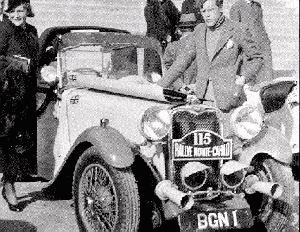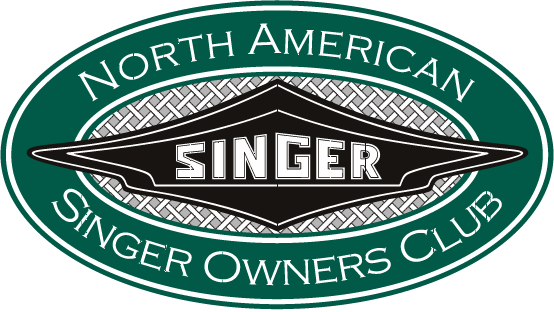Perhaps one of the most interesting Singer owners in the history of the Marque, was a gentleman by the name of Merlin Minshall. Merlin, at one point in his colourful life, was a member of the Special Branch of British Naval Intelligence and interestingly enough, a colleague of Ian Flemming, inventor of the James Bond character. Based on Merlin’s many interesting and dangerous exploits, there is some speculation that the persona of James Bond was, at least in part, based on that of Merlin Minshall. Minshall, himself, however, explained “I don’t know. I didn’t find Flemming a very likable fellow”.
Minshall’s exploits were wild and varied, usually precipitated by the need to be the first Englishman to do whatever it was that he proposed to do. For example, he proposed to be the first Englishman to travel by sail over the Vosges mountains, then over the Bavarian Alps to the Danube to reach the Black Sea.
Starting out with his wife Elizabeth, the romance of the adventure and their marriage quickly evaporated and Merlin was left to sail single handedly, with the exception of the meager assistance of a handful of transient passengers that joined briefly at various points of his voyage. One of these transients it seems, turned out to be a beautiful German agent, with whom he fell greatly in lust. Their meeting, though, was not coincidental. She had been sent on a mission to determine whether he was charting the waters of the Danube and various oil storage facilities on behalf of British intelligence in anticipation of the impending war. Upon her departure, she tried, unsuccessfully to poison him. Unfortunately for the German government, he did survive and both his knowledge and the records he maintained were later conscripted in a plot to block the Danube.
Minshall was the first person to cross the Sahara on a motorcycle. He was the first to identify to Winston Churchill the truth about General Tito’s partisans. He even at one point consorted to commit murder on the Orient Express.
Our real interest, of course, is in how Minshall’s exploits related to Singers. This starts with his voyage home from the Black Sea, sitting in the Dover to London train where he read an article in The Autocar which discussed the prospects for the year’s Monte Carlo Rally. Easily spurred into action, Minshall decided to try his hand at professional auto racing.
The Monte Carlo Rally was one of the craziest and toughest motorsport events ever devised. About 100 expensive vehicles were entered on an annual basis, with a large number becoming write-offs before the end of the rally.
The Rally usually started in mid-winter at various Northern locations and followed a predetermined route half way across Europe to Monte Carlo, covering a distance of approximately 3000 miles. The entire distance was to be covered at a controlled average speed, which meant driving non stop for about 96 hours.
Minshall entered a 1.5 Litre Le Mans Special, registered BGN1, a Singer which had nearly won at Le Mans. With a flare for invention, he developed a large scale map of the race route, driven by a scaled synchromesh run off the transmission shaft. He re-mounted the headlamps so that they would turn with the steering to cast a better light on the road, a feature that Citroen would adopt some twenty-five years later. He also kept a steady supply of warm food and drink which simmered on the exhaust manifold.
He re-mounted the headlamps so that they would turn with the steering to cast a better light on the road, a feature that Citroen would adopt some twenty-five years later. He also kept a steady supply of warm food and drink which simmered on the exhaust manifold.
Then, with his recently acquired mistress Yvette, he drove to Lapland at the Arctic circle, the starting point for the year’s race, to line up in competition with the professionals. Despite his inexperience, he was the first to arrive at Stockholm and the only entrant to enter Copenhagen on time, giving him a tremendous advantage over the professionals in the race. Beyond this point, however, his troubles began.
In Germany, he was flagged down by a German officer with a luger, when he attempted to pass a group of Nazi storm troopers. Apparently it was against regulation to pass armed German troops at greater than walking pace and ignorance of this regulation didn’t save Minshall from arrest. Yvette’s winning smile, however, was able to convince the arresting officer that they meant no harm and they were on their way 30 seconds later. Pushing their speed to over 90 m.p.h., they made up for lost time and reached the Brussels control point with three minutes to spare.
Their next encounter with the lunacy of bureaucracy was at the French frontier of Mauberge, where Minshall and twenty other competitors were trying to get their papers processed by a mean spirited bureaucrat disinclined to hurry. When a French competitor jumped the line and presented his passport and papers wrapped in a 10,000 franc note, the bureaucrat’s enthusiasm perked up immediately. So too did that of the whole group of drivers, which jumped into their cars, without having their papers processed, and continued on to Monte Carlo. The absence of stamped passports would only cause minor difficulties at the end of the race, once the participants began leaving the country for home.
In all, Minshall had outperformed the majority of the professional drivers. However, he quickly learned that the professionals and the race organizers in general were not about to allow a rank amateur to walk away with a win in such a prestigious race. His arrival at Copenhagan as the only entrant to do so on time should have given him a second place showing in the rally. However, as none of the professionals had managed to replicate this achievement, Copenhagan was eliminated as an official control point and Minshall’s status dropped to 5th place overall, but first in the under 1500cc class.
Perhaps this spurred him on to greater challenges, as over the next several years, Minshall and his Singer became regular challengers on the international racing circuit. He participated in the Liege-Rome-Liege, a second run at the Monte Carlo, the Mille Miglia and of course, Le Mans.
Perhaps the highlight of Minshall’s racing career was his participation in the1937 Italian Foreign Challenge Trophy, where he received Mussolini’s Gold Cup directly from the hands of Il Duce himself.
The Foreign Challenge was the longest road race ever held, covering 4000 miles in 3 days. Since most cars in those days couldn’t do more than 90 m.p.h., this was a substantial challenge. Combined with the highly nationalistic fervor raised by the race, and the pressure on the Italian teams to win an event sponsored by the Fascist Party, this was indeed a difficult race for a foreigner to win.
The race commenced at midnight with over 400 cars leaving from Rome, driving all night to the coast to be ferried to Sicily. It was a grueling event. After about 2800 miles Minshall had passed several burning cars with bodies strewn over the roadside and witnessed a car which had passed him at speed, slam into a steam locomotive. By the end of the race, there had been an endless series of accidents, 4 drivers dead and over half the cars originally entered had dropped out.
For Minshall though, it had been a great success as he and his Singer had beaten most of the Italian cars, and all of the foreign entrants, including Aston Martin, M.G., Fraser Nash and Riley. This was an exceptional feat, given that all of these were official works entries with the full backing of their factories and Minshall’s Singer was a private entry with no official sponsorship or support.
